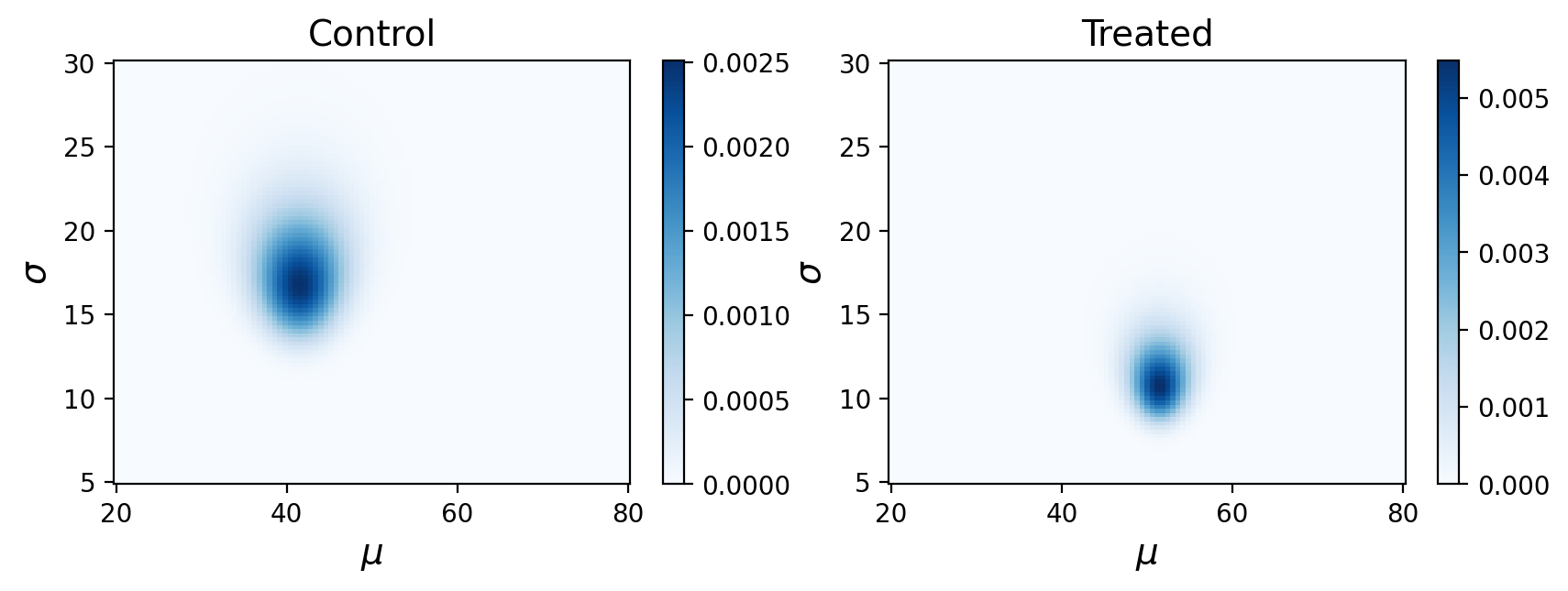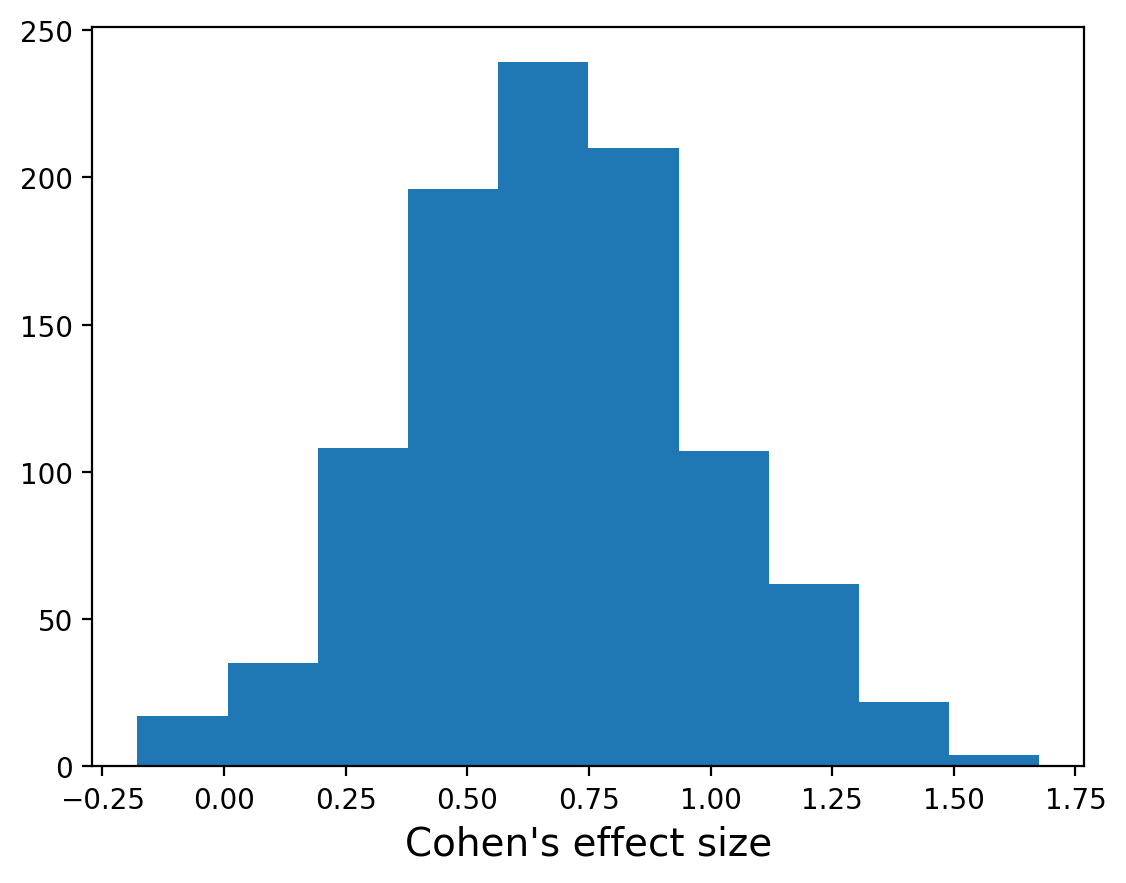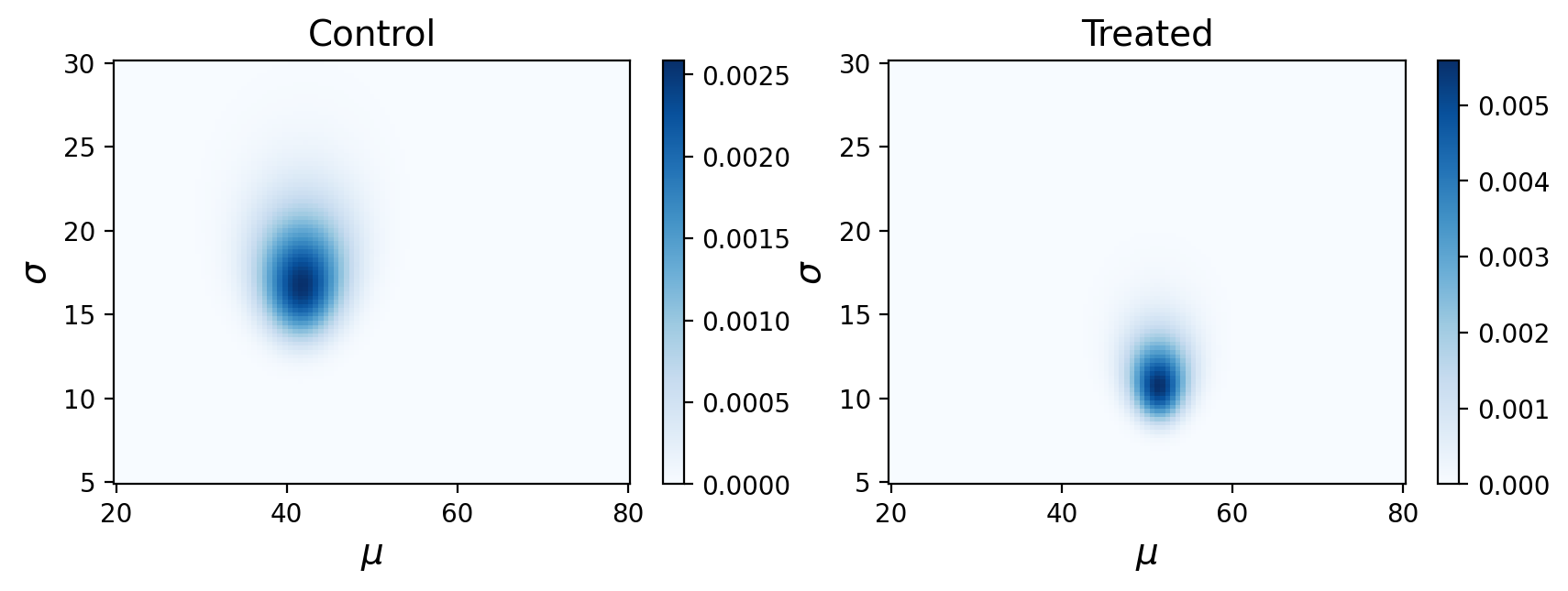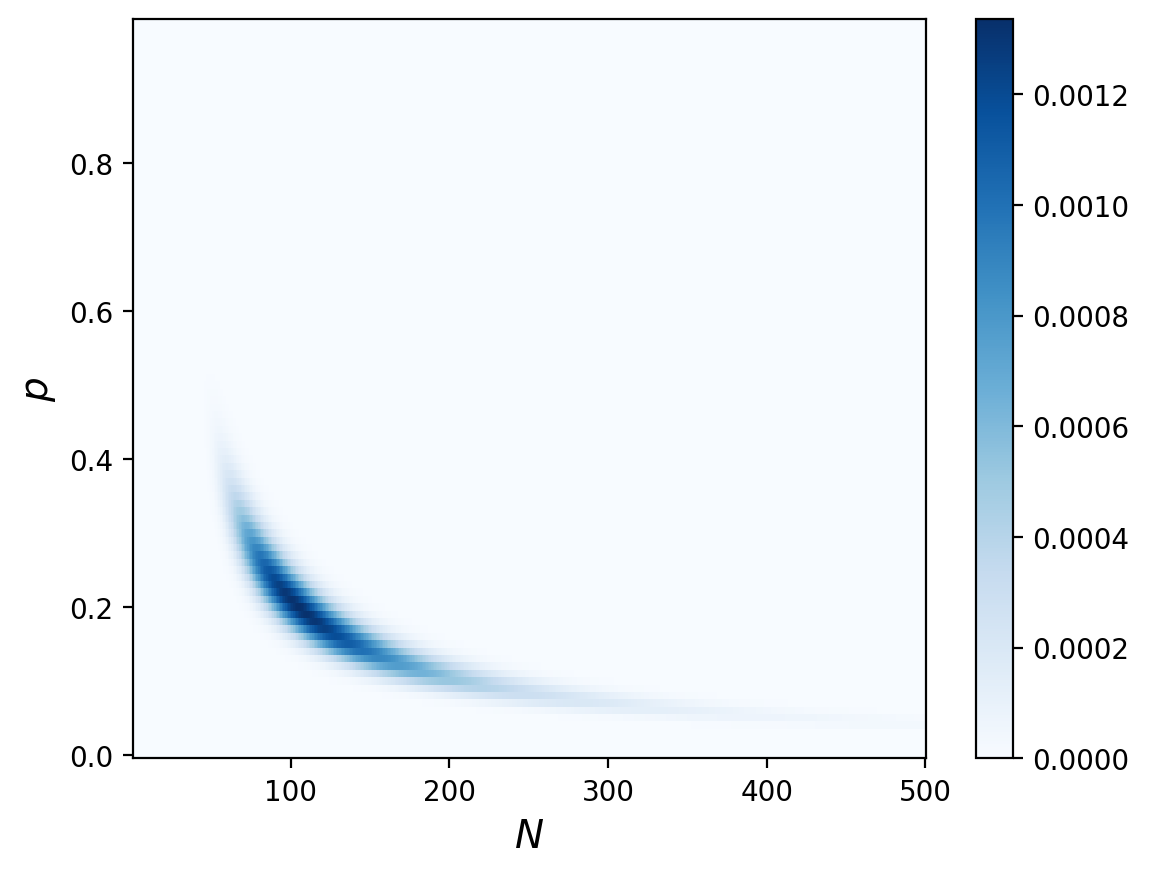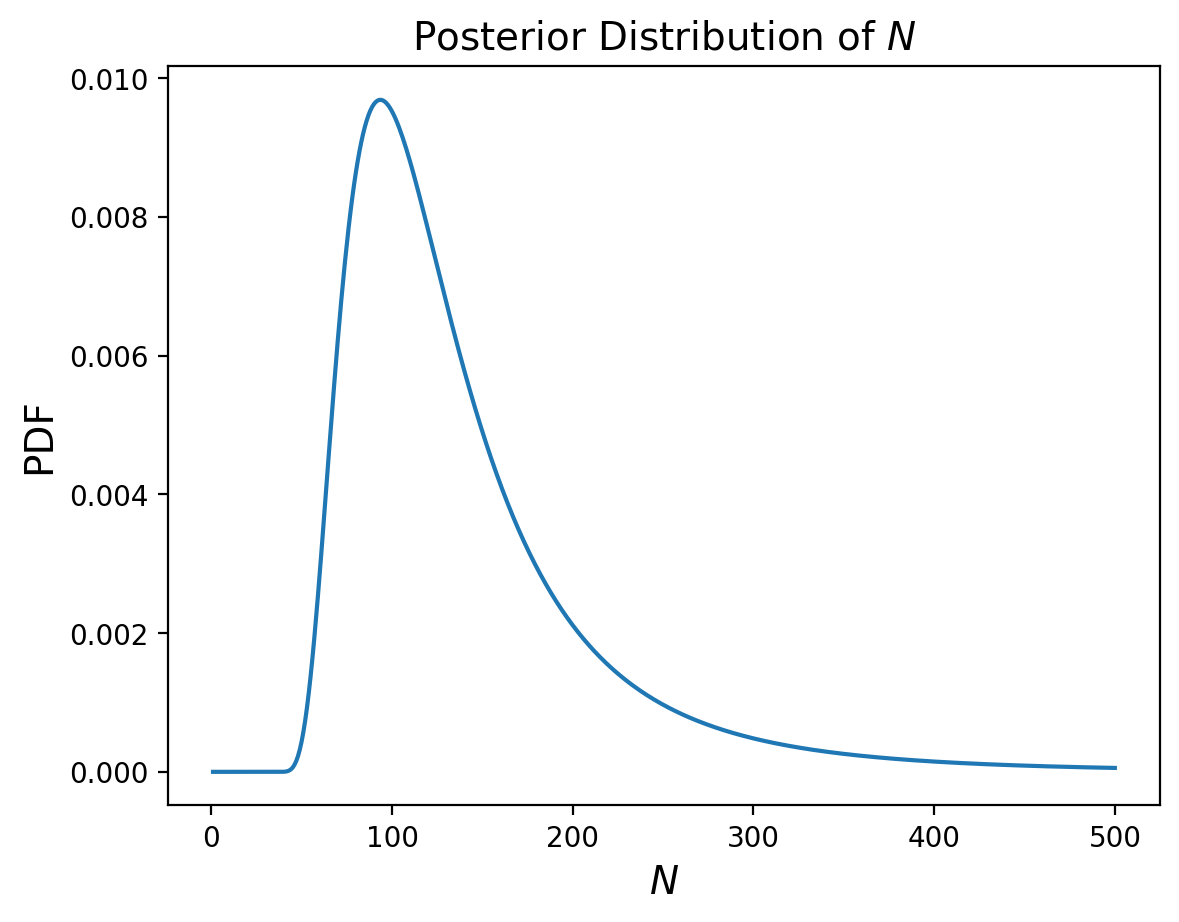Inference (part 2)#
Today we’ll discuss two more useful tools for inference: Effect Size and Empirical Bayes.
Estimating Effect Size#
An effect size is a statistic intended to quantify the magnitude of a phenomenon.
In other words, sometimes we don’t want to just measure the probability that there is a difference between population (e.g. control and treatment), but rigorously determine how much of a difference there was (e.g. beyond looking at the difference in means).
One popular way to measure effect size is called Cohen’s Effect Size.
If the parameters for Group 1 are \((\mu_1,\sigma_1)\), and the parameters for Group 2 are \((\mu_2,\sigma_2)\), Cohen’s effect size \(d\) is:
A useful feature of Cohen’s \(d\) is that it can indicate when a sample size is too small. A large difference in means with a small effect size typically means more data should be collected.
Direct Calculation#
We’ll test out estimating effect size on our control and treatement example from the previous lecture.
One option is to direcly calculate the effect size from our data based on expected values of the mean standard deviation for each distribution. These were the posterior distributions we observed before:
# calculate means and standard deviations from marginals
mu1 = np.sum(posterior_treated.columns * posterior_treated.sum(axis=0))
mu2 = np.sum(posterior_control.columns * posterior_control.sum(axis=0))
sd1 = np.sum(posterior_treated.index * posterior_treated.sum(axis=1))
sd2 = np.sum(posterior_control.index * posterior_control.sum(axis=1))
# calculate Cohen's d
(mu1 - mu2)/((sd1 + sd2) / 2)
0.66480357657799
This is a reasonably large effect size, though perhaps you would want to collect more data to be more convinced.
Posterior Distribution of Effect Sizes#
We can take this a step further though. We don’t have to just use the means of our posterior distributions. We can actually use the entire posterior distributions to get a posterior distribution for Cohen’s effect size!
To do this, you would enumerate all pairs of \(\mu\)s and \(\sigma\)s from the two distributions and compute the Cohen’s \(d\) for each.
One way of using the entire distribution is by sampling 1000 pairs of \(\mu\)s and \(\sigma\)s at random (note, don’t worry about the details of the sampling, but just note that we draw means and standard deviations proportionally to their probability) and computing the Cohen’s \(d\) for each pair.
# sample from posterior distributions
sample_treated = np.random.choice(posterior_treated.transpose().stack().index, 1000, p=posterior_treated.transpose().stack())
sample_control = np.random.choice(posterior_control.transpose().stack().index, 1000, p=posterior_control.transpose().stack())
# compute cohens d for all sampled pairs
ds = []
for pair1, pair2 in zip(sample_treated, sample_control):
mu1, sd1 = pair1
mu2, sd2 = pair2
d = (mu1 - mu2) / ((sd1 + sd2) / 2)
ds.append(d)
We can calculate the mean of this distribution, which should give us a similar result to before:
np.mean(ds)
0.6811650994860181
But now can also get the probabilty the effect size is greater than 0:
(np.asarray(ds)>0).sum()/1000
0.983
And calculate the 90% credible interval for the effect size:
[np.quantile(np.asarray(ds),.05),np.quantile(np.asarray(ds),.95)]
[0.18597495527728086, 1.2003870967741936]
Empirical Bayes#
Empirical Bayes is statistical inference in which the prior probability distribution is estimated from the data.
Recall that for the train problem we reasoned that a train-operating company with 1000 locomotives is not just as likely as a company with only 1, so we switched from a uniform prior to a power law prior.
But we also noted that perhaps we could also directly use some data (e.g. a survey of train operators).
In some cases, we actually use the very same data we plan to use for our updates. This is in stark contrast with our standard procedue where the prior distribution is fixed before any data are observed (it’s always our first step before calculating any likelihoods).
Basically this means using data twice, once for the prior and once for the update. While that might seem problematic (and some data scientists think it is) its a commomly used strategy to construct priors.
For example, lets use the mean and standard deviation of the test scores for the prior distribution of \(\mu\) in the control/treatment data we’ve been using, and from there just run all the same code as before:
# empirical Bayes prior for mu
prior_mu = pd.DataFrame(index = np.linspace(20, 80, num=101))
prior_mu ['probs'] = norm.pdf(prior_mu.index, np.mean(df.Response), np.std(df.Response))
# uniform prior for sigma
prior_sigma = pd.DataFrame(index = np.linspace(5, 30, num=101))
prior_sigma ['probs'] = 1/101
In this case our output is nearly identical. The advantage of the Empirical Bayes approach is that it could potentially find this joint posterior with less data.
Emprical Bayes can take many forms and has varying degrees of success. One common (and less controvertial) way to use it is simply to constrain the search space of your parameters (e.g. calculate the max and min possible \(\mu\) and only test those values).
The Grizzly Bear Problem#
Finally today, we’ll do one more example problem using Bayesian inference.

In the 90s, Canadian scientists wanted to figure out how many grizzly bears there were in a portion of the rockies. They set out traps to tag (and release) bears (they got 23) . Then they did this a second time and counted how many of the bears they trapped the second (they got 19) time were tagged (i.e. trapped twice, 4 of them were). Using these numbers, how many bears are there?
Approaching the problem#
Let’s think about this in terms of two paramters. There’s some number of bears \(N\) and some probability of trapping any given bear \(p\) (let’s assume this probabilty doesn’t change from round to round). We’ll also assume (maybe incorrectly) that the probability a bear is observed in the second round does not depend on whether it was observed in the first round (i.e. we’ll assume independence).
If we were trying to find the probability of \(N\) bears being trapped once with probabilty \(p\), this would follow a simple Binomial distribuion.
It turns out though that there is a multinomial distribution, which is just a generalized bionomial to multiple probabilities.
For \(N\) trials and \(k\) mutually exclusive events each with probability \(p\), the probability of any particular combination of numbers of successes \(x\) for the various categories is:
We’ll use this to calculate our likelihoods.
The Prior#
We’ll start with uniform priors for our two parameters \(N\) and \(p\).
from scipy.stats import randint
# uniform prior for N
prior_N = pd.DataFrame(index = np.linspace(1, 500, num=500))
prior_N ['probs'] = 1/500
#uniform prior for p
prior_p = pd.DataFrame(index = np.linspace(.0, .99, num=100))
prior_p ['probs'] = 1/100
# multiplies prbabilities from two distributions
def make_joint(pmf1, pmf2):
"""Compute the outer product of two Pmfs."""
X, Y = np.meshgrid(pmf1['probs'], pmf2['probs'])
return pd.DataFrame(X * Y, columns=pmf1.index, index=pmf2.index)
prior = make_joint(prior_N, prior_p)
The Likelihood#
Using the multinomial, we can calculate the probability for trapping bears multiple times for each \(N\) and \(p\).
To apply the multinomial we have to consider the four mutually exclusive events for each bear: never caught, caught first time, caught second time, caught both times.
Scenario |
Number of Bears |
Probability |
|---|---|---|
Never |
N - 23 - 19 + 4 |
\((1-p)^2\) |
First |
23 - 4 |
\(p(1-p)\) |
Second |
19 - 4 |
\(p(1-p)\) |
Both |
4 |
\(p^2\) |
from scipy.stats import multinomial
likelihood = [[multinomial.pmf([N - 23 - 19 + 4, 23 - 4, 19-4, 4], N, [(1-p)**2,p*(1-p),p*(1-p), p**2])
for N in prior.columns] for p in prior.index]
likelihood = np.array(likelihood)
The Update#
Same as always:
posterior = prior * likelihood
prob_data = posterior.to_numpy().sum()
posterior = posterior / prob_data
And let’s compute the posterior marginal to look at just the number of bears:
marginal_N = posterior.sum(axis=0)
And now that we have our posterior distribution of N, we can calculuate the MMSE to guess how many bears there are:
np.sum(marginal_N.index*marginal_N)
138.66656942721932
